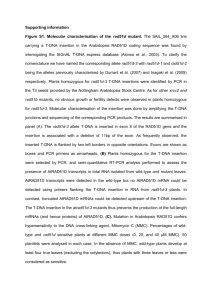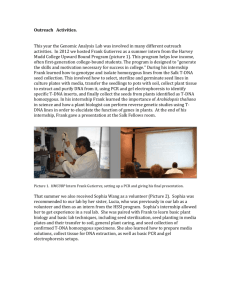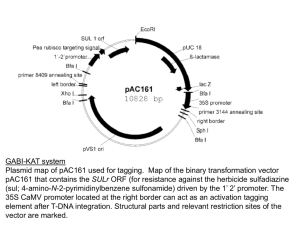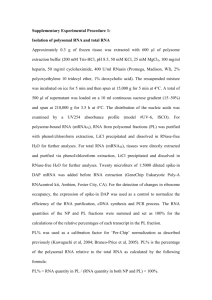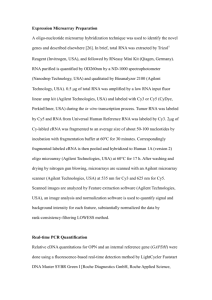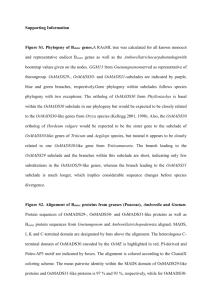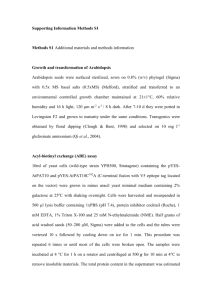NPH_3619_sm_FigsS1-S8-TablesS1-S5-MethodsS1
advertisement
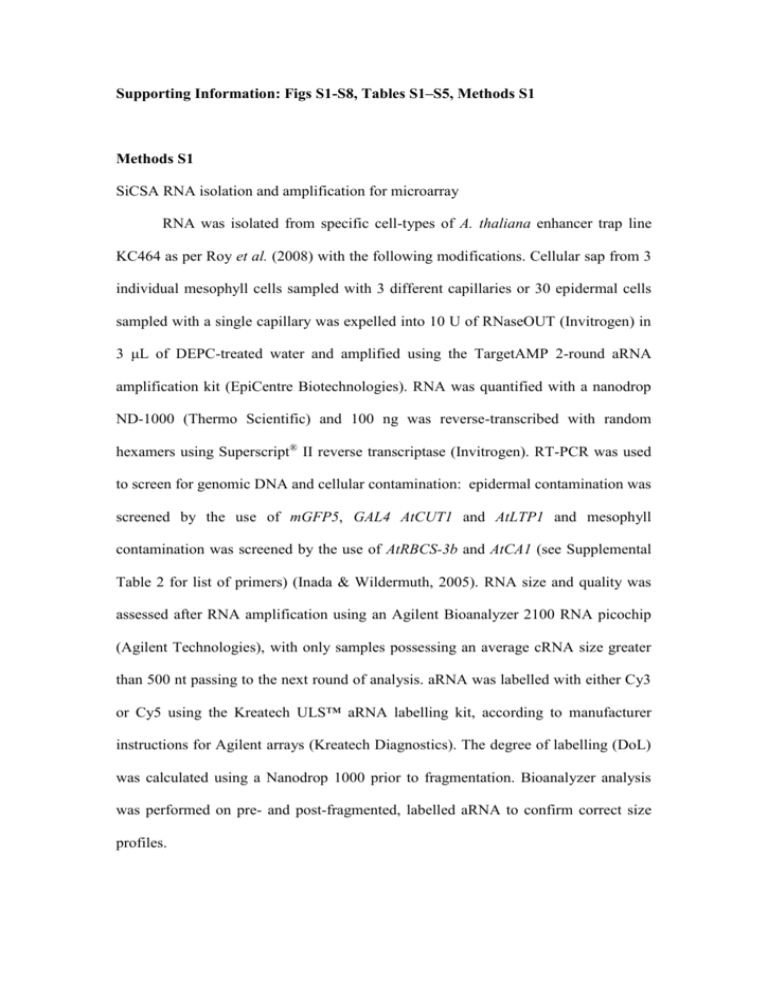
Supporting Information: Figs S1-S8, Tables S1–S5, Methods S1 Methods S1 SiCSA RNA isolation and amplification for microarray RNA was isolated from specific cell-types of A. thaliana enhancer trap line KC464 as per Roy et al. (2008) with the following modifications. Cellular sap from 3 individual mesophyll cells sampled with 3 different capillaries or 30 epidermal cells sampled with a single capillary was expelled into 10 U of RNaseOUT (Invitrogen) in 3 μL of DEPC-treated water and amplified using the TargetAMP 2-round aRNA amplification kit (EpiCentre Biotechnologies). RNA was quantified with a nanodrop ND-1000 (Thermo Scientific) and 100 ng was reverse-transcribed with random hexamers using Superscript® II reverse transcriptase (Invitrogen). RT-PCR was used to screen for genomic DNA and cellular contamination: epidermal contamination was screened by the use of mGFP5, GAL4 AtCUT1 and AtLTP1 and mesophyll contamination was screened by the use of AtRBCS-3b and AtCA1 (see Supplemental Table 2 for list of primers) (Inada & Wildermuth, 2005). RNA size and quality was assessed after RNA amplification using an Agilent Bioanalyzer 2100 RNA picochip (Agilent Technologies), with only samples possessing an average cRNA size greater than 500 nt passing to the next round of analysis. aRNA was labelled with either Cy3 or Cy5 using the Kreatech ULS™ aRNA labelling kit, according to manufacturer instructions for Agilent arrays (Kreatech Diagnostics). The degree of labelling (DoL) was calculated using a Nanodrop 1000 prior to fragmentation. Bioanalyzer analysis was performed on pre- and post-fragmented, labelled aRNA to confirm correct size profiles. Custom 4 x 44 k Agilent DNA microarrays designed using eArray v.5.3.1 (Agilent Technologies), incorporating the entire Arabidopsis 3 oligo gene list, in addition to user defined probes for both mGFP5 and GAL4-VP16 and duplicates of known leaf-expressed ion transporters (Design ID: 017700), were used in this study. Eight hundred and twenty-five nanograms of Cy3 and Cy5 labelled aRNA was hybridised to each array, washed and scanned as per manufacturer’s instructions for two-colour arrays and imaged on an Agilent Microaray Scanner in XDR mode. Image files were processed and within-slide normalization was carried out using Agilent's "Feature Extraction Software" (V. 9.5.3.1, Agilent Technologies). Additional between-slide normalization was not undertaken because this would be compromised by the expected stochastic related fluctuations in gene expression within individual cells (Elowitz et al., 2002). Instead, a list of putatively differently expressed genes was prepared by splitting transcripts into groups that were consistently expressed at very high levels (log2(expression) > 13.3) in one cell-type while being consistently expressed at below background levels (log2(expression) < 8.0) in the other tissue. Hybridised arrays were omitted from analysis if they contained control genes from both an epidermal and mesophyll origin (see Supplemental Table 2 for list of control genes), or they did not pass standard quality control tests (Bioanalyzer median aRNA product size > 500 nt and sufficient fluorescence degree of labelling). References Elowitz, M.B., Levine, A.J., Siggia, E.D., and Swain, P.S. (2002). Stochastic gene expression in a single cell. Science 297: 1183-1186. Inada N, Wildermuth MC. 2005. Novel tissue preparation method and cell-specific marker for laser microdissection of Arabidopsis mature leaf. Planta 221: 9-16. Roy SJ, Gilliham M, Berger B, Essah P, Cheffings C, Miller AJ, Widdowson L, Richardson P, Leigh RA, Tester M. 2008. Investigating glutamate-like receptor gene co-expression in Arabidopsis thaliana. Plant, Cell and Environment 31: 861-71. Table S1 List of Arabidopsis T-DNA insertion lines investigated in the course of this study MRS2 Loci AtMRS2-1 AtMRS2-5 AtMRS2-10 SALK ID Line name Primers for confirming insertion site (5’ → 3’) T-DNA Insertion site SALK_006797 SALK_038768 SALK_139989 SALK_105475 SALK_115410 SALK_100361 SALK_006528 mrs2-1a (2-1a) mrs2-1b (2-1b) mrs2-1c mrs2-5a (2-5) mrs2-5b mrs2-10a (2-10) mrs2-10b LP: tctgtttgggctaattggttg; RP: gataaaagcttgagcattgcg LP: catagctgaagcaggtcttgg; RP: agatgctccaccggttaagtc n.d. LP: ccagtcggaactgtgtaaacg; RP: tgattctgcacattccccagc n.d. LP: cagtaccagagctcatggacg; RP: tcccacaaaatcagatggatc n.d. 3rd Intron/4th Exon Promoter 4th Exon 4th Exon 5‘ UTR 4th Exon 5‘ UTR Loss of functional transcript + + + + - Lines with a verified loss of transcription (+, see Fig. S1A) are highlighted and were used for phenotype screening. In three cases homozygous T-DNA insertions did not lead to a loss of intact mRNAs (-) and so were excluded from this assay (Fig. S1). Primers used to confirm T-DNA insertion site (LP, and RP) calculated from Signal SALK website (http://signal.salk.edu/tdnaprimers.2.html). Results presented in Gebert et al. (2010) were confirmed in our study. n.d. not determined. Table S2 Recipes for hydroponics growth solutions utilised in this study Final conc (mM) LCS 2 Macronutrients Stock Conc. (M) NH4NO3 1 BNS 2 KNO3 1 3 5 3 CaCl2•2H20 KCl Ca(NO3)2•4H20 1 1 0.4 0.1 2 2 0.05 0 0 0.9 2 2.2 MgSO4•7H20 0.4 2 4.5 3.5 KH2PO4 0.1 0.6 6 0.6 NaCl NaNO3 Mg(NO3)2•6H20 MgCl2 K2SO4 1 1 0.4 0.5 0.1 0.4 1.2 0.5 0 0 1.7 0 0 14.5 0.2 Micronutrients NaFe(III)EDTA H3BO3 1.5 0 0 0 0 NaOH to pH 5.6 Stock Conc. (mM) 50 50 50 50 Final conc (μM) 50 50 HMS 2.3 50 50 MnCl2•4H20 5 10 10 10 ZnSO4•7H20 10 150 150 150 CuSO4•5H20 0.5 1 1 1 Na2MoO3 0.1 0.5 0.5 0.5 Table S3 Primers used for qPCR analysis. Amplification efficiency (E) of each primer pair calculated across 5 serial log dilutions, with Ct values plotted against log10 (concentration) using qGene software Gene AGI Forward Primer (5’→3’) Reverse Primer (5’→3’) AtEF-1α Atβ-Tubulin5 AtActin2 AtGAPDH-A AtCUT1 AtLTP1 GAL4 mGFP5 AtCA1 AtRBCS-3b AtMRS2-1 AtMRS2-4 AtMRS2-5 AtMRS2-10 AtMRS2-11 AtMHX1 AtCAX1 At1g07940 At1g20010 At3g18780 At3g26650 At1g68530 At2g38450 N/A N/A At3g01500 At5g38410 At1g16010 At3g58970 At2g03620 At1g80900 At5g22830 At2g47600 At2g38170 gacaggcgttctggtaaggag cgtgaaatccagcgtttgtga tgagcaaagaaatcacagcact tggttgatctcgttgtgcaggtctc cattcacgcaggaggcagag atagccaagacgaccccaga cggaggagagcagcaacaag tgtccttttaccagacaaccatta gtgaaagggaggcggtgaa tgactaccttctccgcaacaa gatctttgggatgaactttgag cattgacgacacagaagactacg tccgacgactttccagtatgt tcagaagacgcaaccgaga tgaggaagaagaggaggaaatc atcgtggtgcttgtgttgag catcatcgtggcgtggatt gcggaaagagttttgatgttca tcgtccattccttctcctgtg cctggacctgcctcatcatac gtcagccaagtcaacaactctctg ccacacggcagagttacacttg tagctcatcacctcacggttt attccaagggcatcggtaaac agctgttacaaactcaagaagga atcacagtcaaaggcacattacaa gcattcttcaacttccttcaacac gtctactttctggggagcaca tggtttgtaagagagagggagat tgcgtcttcttcttcttctctaac accccgaagatggctaca cccgttgttagccagaatg ttttccttttgttgcttcttct gcattttgtttctggggaagt Product Length (bp) 275 171 166 263 229 179 265 103 288 181 181 290 138 218 282 167 207 Amplification Efficiency (E) 1.98 1.98 1.99 1.97 1.96 1.97 1.95 1.96 1.95 1.99 1.99 1.95 1.98 1.96 1.98 1.97 2.00 The slope of this standard curve was used in the following equation to calculate E; E = 10(-1/slope), with each qPCR performed in triplicate. Table S4 Primers for amplification of the coding sequence of MRS2s for generating YFP fusions and for complementation experiments as described in Materials and Methods Gene Forward Primer (5’→3’) Reverse Primer (5’→3’) AtMRS2-1 AtMRS2-5 AtMRS2-10 atgtctgagctaaaagagcg atgggagaacaactagatcca atgtctgaactcaaagagcgtttg ttatagaggcatgagtcttctgtac tcagagagggaatactttcttg tcacagaggcatgagtcttctacg Reverse Primer minus stop (5’→3’) tagaggcatgagtcttctgtacttg gagagggaatactttcttgtgc cagaggcatgagtcttctacgtttg Table S5 Leaf water content and soluble sugar concentration of Col-0, and all mrs2 T-DNA insertion lines utilised in this study, grown in both BNS and LCS hydroponics conditions Leaf Water Content (WCOM) Soluble Sugar Conc. (mg.g-FW-1) Line Col-0 mrs2-1a mrs2-1b mrs2-5 mrs2-10 cax1/cax3 BNS LCS BNS LCS 89.99 ± 0.33 90.05 ± 0.39 89.84 ± 0.67 89.36 ± 0.55 89.93 ± 0.41 89.30 ± 0.82 89.50 ± 0.59 90.04 ± 0.92 89.35 ± 0.80 90.01 ± 0.71 89.57 ± 0.38 90.14 ± 0.66 21.41 ± 0.67 21.03 ± 0.56 21.29 ± 0.64 21.13 ± 0.67 21.31 ± 0.88 26.31 ± 0.88 22.25 ± 0.48 22.07 ± 0.51 22.09 ± 0.64 22.12 ± 0.46 22.20 ± 0.19 20.80 ± 0.39 Shoots of 6-wk-old plants grown for one week in BNS or LCS were excised and weighed (fresh weight, FW), dried at 42oC for 48 h (dry weight, DW) (mean ± SEM.; n = 6 plants). Water content presented as mass of water (FW-DW) per mass of organic matter (WCOM). Soluble sugar concentration calculated from 3 independent plants under each treatment with data shown as mean ± SEM. Fig. S1 Confirmation of homozygosity for T-DNA insertion lines of MRS2 genes used in this study and location of T-DNA inserts. (a) PCR used to amplify the entire coding region of AtMRS2-1, AtMRS2-5 and AtMRS2-10 from each SALK T-DNA insertion line and the Col-0 (wild-type) background. Underlined are the lines lacking corresponding gene transcript. (b) Image showing insertion site of all loss of transcript lines and naming conformity referred to in (a). 2,500 bp of genomic sequence (sense orientation) incorporating the gene is shown to scale with exons (shaded boxes), introns (unshaded boxes), 5’ and 3’ non-coding regions (unfilled lines) and the insertion site(s) and direction (arrow) of T-DNAs. Fig. S2 Standard curves used to quantify magnesium concentration by both (a) single cell sampling and analysis (SiCSA), or (b) cryogenic scanning electron microscopy (cryo-SEM) in combination with X-ray microanalysis (XRMA). For (a), equal volumes (≈20 pl) of internal standard (250mM rubidium fluoride (RbF) in 250mM Mannitol) and a dilution series from 1.25-200 mM MgCl2 was spotted onto 1% (w/v) pioloform-coated copper SEM grids, respectively. Each concentration was spotted in quintuplicate and grids were prepared and analysed as for other SiCSA samples. For (b), dilution of calibration solution was mixed with 5% (w/v) colloidal graphite/carbon that had been ballmilled and passed through a 50 mm sieve (Treeby et al., 1987). Solutions were placed in a brass stub and prepared identically to plant material analysed by cryo-SEM as per described methods. Data was analysed with XRMAplot and plotted to form standard curves for each element. Filled circle indicates detection limit for magnesium for each method, defined as the first point distinguishable from 0 mM Mg, which is 15 mM for SiCSA and 35 mM for cryoSEM. Fig. S3 Validation of SiCSA-based RNA sampling and amplification for qPCR and microarray study using the enhancer trap line, KC464. qPCR check of cell-specific gene expression and contamination of palisade mesophyll samples by RNA from adaxial epidermal cells. RNA was amplified from samples taken from 30 adaxial epidermal cells and 3 palisade mesophyll cell of leaf 8 of 6-wk-old KC464 plants. Data are normalised against AtEF1α (At1g07940), Atβ-Tubulin5 (At1g20010) and AtActin2 (At3g18780). Three independent amplifications were performed, with data presented as mean normalised expression levels ± SEM (n = 3 PCR technical repeats). Cell-specific genes showed the expected pattern for epidermis, AtCUT1, AtLTP1 and mesophyll RBCS-3b, AtCA1 (Brandt et al., 2002; Inada and Wildermuth, 2005). GFP and GAL4 transcripts were also found only within the epidermal RNA samples as expected from GFP fluorescence profile. Equally amplified transcripts AtEF1a and Atβ-Tubulin5 were normalised against AtActin2, known to be expressed in both cell types (Laval et al., 2002). Primers listed in Supplemental Material Table S2. Fig. S4 AtMRS2-1 and AtMHX expression are positively correlated with leaf [Mg] and inversely correlated with leaf [Ca] in Arabidopsis thaliana ecotypes. Correlation of inductively-coupled plasma (ICP) spectroscopy and microarray data across 23 Arabidopsis ecotypes, reinforcing the importance of mesophyll enriched MRS2s in leaf Mg accumulation. Normalised microarray data for of (a-b) AtMRS2-1, (c-d) AtMRS2-4, (e-f) AtMRS2-10, (g-h) AtMRS2-11, and (i-j) AtMHX obtained from Affymetrix Arabidopsis ATH1 Genechip® arrays performed by Lempe et al. (2005) and ICP data obtained from Purdue ionomics information management system (PiiMS) database (Baxter et al., 2007)(www.ionomicshub.org) on leaves of plants grown in soil with the same fertilization and light regimens. Weight normalised values (in ppm) were utilised and presented relative to Columbia-0 to facilitate interexperimental normalization of ICP data for (a,c,e,g,i) magnesium and (b,d,f,h,j) calcium (Mean ± SEM). Linear regression line shown in red, r2 values calculated using PRISM ver. 5.1 (GraphPad software). Correlations with AtMRS2-5 were not possible given there was no probe sets for this transcript on the ATH1 array. Figure S5. Subcellular localisation of N-terminal and C-terminal YFP fusions with the PM-localised AtMRS2-10 showing (a) diffuse cytosolic localisation as an N- terminal fusion, yet (b) discrete plasma membrane targeting as a C-terminal fusion. Cytosolic fluorescence signal for both (c) AtMRS2-1 and (d) AtMRS2-5 as Nterminal YFP fusions. Cells were imaged by confocal fluorescence microscopy as per methods. (e) Predicted cleavage site at the N-terminus (aa16-19) of AtMRS2-10 using the SignalP 3.0 server (Bendtsen et al., 2004). Fig. S6 Perturbations in mesophyll vacuolar Mg accumulation in T-DNA insertion lines under serpentine conditions only confirmed for AtMRS2-1 and AtMRS2-5. Cellspecific vacuolar [Mg] determined by SiCSA/XRMA on adaxial epidermis and palisade mesophyll of 6-wk-old Arabidopsis plants grown in hydroponics solutions: (a) basal nutrient solution or (b) high magnesium solution after 4 d (Mean + S.E.M; n = 25 cells of each type, from 5 independent plants). Asterisk indicates significant difference determined by one-way ANOVA (P < 0.05). Fig. S7 Elemental (Mg, K, Ca) responses of Arabidopsis Col-0 mesophyll over 7 d growth in LCS as determined by SiCSA/XRMA (Mean ± SEM.; n = 50 mesophyll samples, from 10 independent plants, experiment performed in duplicate). Fig. S8 Correlation between growth rate and (a) chlorophyll content, or (b) leaf osmolality in Col-0, mrs2-1a, mrs2-1b, mrs2-5, mrs2-10 and cax1/cax3 lines grown in both BNS- and LCS-hydroponics.

